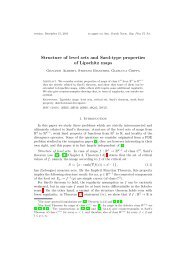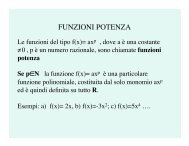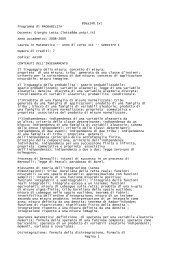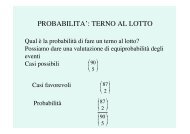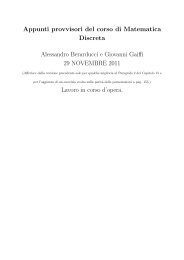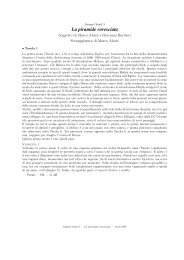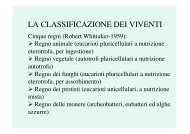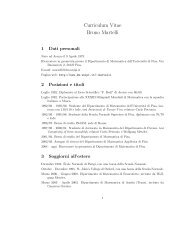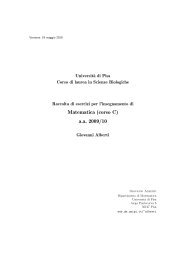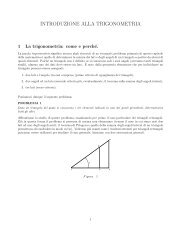Immersioni aperte in dimensione infinita - Dipartimento di Matematica
Immersioni aperte in dimensione infinita - Dipartimento di Matematica
Immersioni aperte in dimensione infinita - Dipartimento di Matematica
You also want an ePaper? Increase the reach of your titles
YUMPU automatically turns print PDFs into web optimized ePapers that Google loves.
2.2 Mappe <strong>di</strong> Fredholm <strong>di</strong> <strong>in</strong><strong>di</strong>ce zero proprie e limitate 31<br />
Osservazione 2.32. Scopo della presente osservazione è provare <strong>in</strong> dettaglio l’implicazione<br />
sh −−−−−→<br />
h→+∞<br />
+∞ =⇒ Tsh f ⇀ 0.<br />
Ricor<strong>di</strong>amo che <strong>in</strong> un generico spazio normato X, una successione (xn) <strong>di</strong> X converge debolmente<br />
ad un punto x <strong>in</strong> X se<br />
∀ φ ∈ X ∗ , φ(xn) → φ(x).<br />
Negli spazi <strong>di</strong> Hilbert, <strong>in</strong> virtù del teorema G.20 <strong>di</strong> Riesz, ogni siffatto funzionale φ è rappresentato<br />
da uno ed un solo elemento dello spazio <strong>di</strong> Hilbert stesso, per cui<br />
Tshf ⇀ 0 ⇐⇒ ∀ g ∈ L2 <br />
(R), Tshf, g2<br />
−−−−−→ 〈0, g〉 = 0<br />
h→+∞<br />
⇐⇒ ∀ g ∈ L 2 +∞<br />
(R), lim<br />
h→+∞ −∞<br />
⇐⇒ ∀ g ∈ L 2 +∞<br />
(R), lim<br />
x→+∞<br />
−∞<br />
Tshf(x) g(x) dx = 0<br />
e −(x−t)2<br />
g(t) dt = 0.<br />
(2.2.19)<br />
Quest’ultimo è l’<strong>in</strong>tegrale <strong>di</strong> convoluzione della gaussiana G(x) = e−x2 con la funzione g ∈ L2 (R),<br />
per def<strong>in</strong>izione <strong>di</strong> convoluzione <strong>in</strong>fatti:<br />
G ∗ g(x) :=<br />
+∞<br />
−∞<br />
e −(x−t)2<br />
g(t) dt.<br />
Esistono risultati generali sulla convoluzione da cui il limite 2.2.19 segue subito: <strong>in</strong>vocando il<br />
teorema G.29 <strong>di</strong> cui nell’appen<strong>di</strong>ce G si <strong>di</strong>mostra che se p, q > 1 sono esponenti coniugati (<strong>in</strong><br />
particolare p = q = 2), f ∈ Lp (R) <strong>in</strong> particolare f(x) = G(x) = e−x2 ∈ L2 (R) e g ∈ Lq (R) (nel<br />
nostro caso g ∈ L2 (R) , allora la convoluzione<br />
f ∗ g(x) =<br />
+∞<br />
−∞<br />
f(x − t) g(t) dt<br />
esiste ed è una funzione cont<strong>in</strong>ua e nulla all’<strong>in</strong>f<strong>in</strong>ito. Nell’appen<strong>di</strong>ce G, esempio G.30, si è fornita<br />
a titolo <strong>di</strong> esempio un’altra motivazione che giustifica il limite 2.2.19, senza fare ricorso alla teoria<br />
della convoluzione.<br />
Teorema 2.33. Esiste una mappa <strong>di</strong> classe C ∞ , Fredholm <strong>di</strong> <strong>in</strong><strong>di</strong>ce zero, limitata e propria<br />
f : M → H.<br />
Dimostrazione. Nelle notazioni <strong>in</strong>trodotte nelle <strong>di</strong>mostrazioni delle proposizioni 2.28 e 2.31, l’immag<strong>in</strong>e<br />
<strong>di</strong> f2 è contenuta nel cil<strong>in</strong>dro aperto 〈w〉×D1 := 〈w〉× 〈w〉 ⊥ ∩BO(1) . A meno <strong>di</strong> comporre<br />
f2 con una mappa ra<strong>di</strong>ale, per esempio<br />
(sw, u) ∈ 〈w〉 × 〈w〉 ⊥ ↦−→<br />
<br />
sw,<br />
εu<br />
(1 + |u| 2 ) 1/2<br />
<br />
, (2.2.20)<br />
possiamo supporre che l’immag<strong>in</strong>e <strong>di</strong> f2 sia contenuta nel cil<strong>in</strong>dro chiuso 〈w〉 × Dε fornito dalla<br />
proposizione precedente, <strong>in</strong> modo tale che il prodotto <strong>di</strong> composizione ψ ◦ f2 sia ben def<strong>in</strong>ito ( 5 ).<br />
Posta f := ψ ◦ f2, f sod<strong>di</strong>sfa tutte le richieste dell’enunciato del teorema.<br />
Corollario 2.34. Esiste una mappa <strong>di</strong> classe C ∞ , Fredholm <strong>di</strong> <strong>in</strong><strong>di</strong>ce zero, limitata e propria<br />
f : M → H trasversa ad Hn per ogni n <strong>in</strong> N.<br />
5 Si osservi che, a meno che l’immag<strong>in</strong>e <strong>di</strong> f2 non sia già contenuta <strong>in</strong> 〈w〉×Dε, <strong>in</strong> generale è necessario comporre con<br />
una mappa ra<strong>di</strong>ale del tipo <strong>in</strong><strong>di</strong>cato <strong>in</strong> (2.2.20), <strong>in</strong>fatti, come è esplicitato dalla <strong>di</strong>mostrazione della proposizione 2.31,<br />
è ε < 1<br />
2 |f|| 2 < 3/4<br />
RAUL TOZZI



